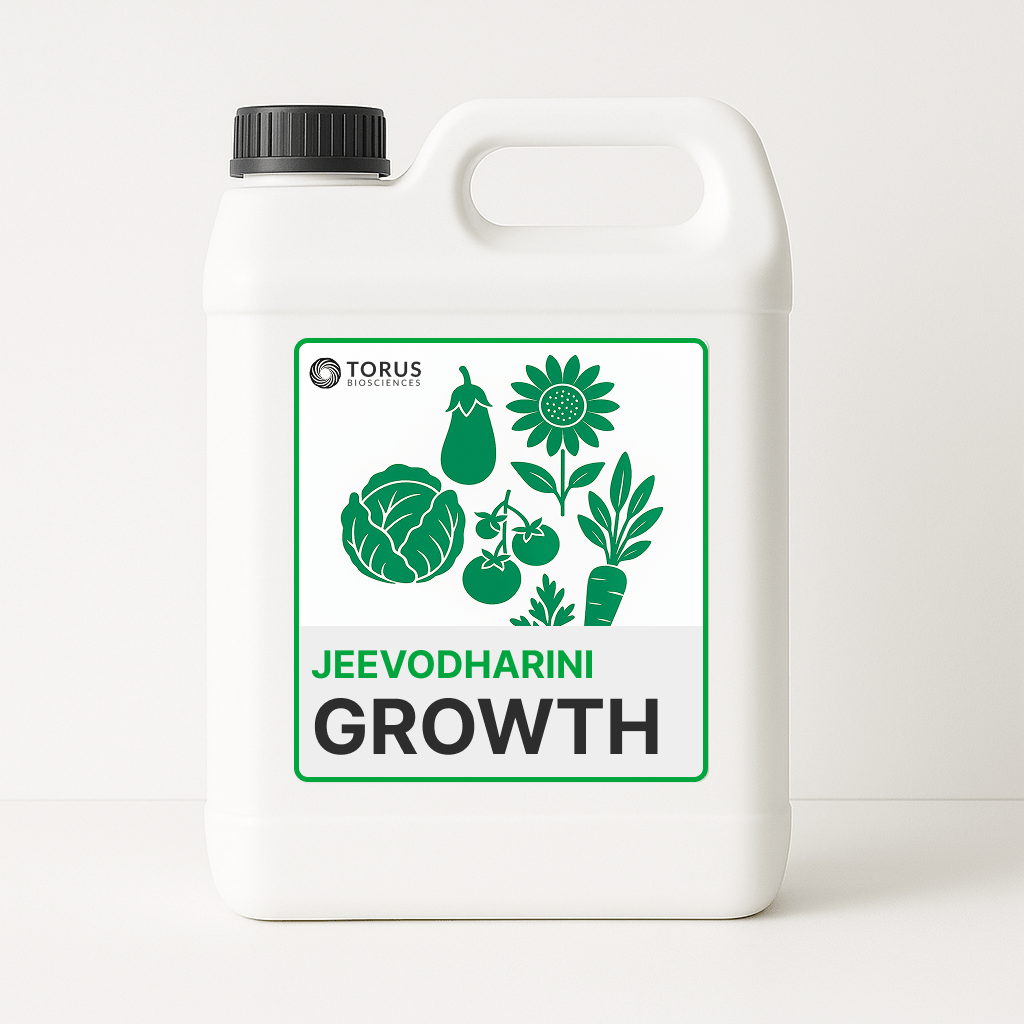
Jeevodharini Growth
A multi-microbial biofertilizer that naturally provides crops with nitrogen, phosphorus, and potassium (NPK) while enhancing root nutrient uptake through Vesicular Arbuscular Mycorrhiza (VAM).

Jeevodharini Growth delivers essential macronutrients through beneficial microorganisms that create a comprehensive nutrient ecosystem in the rhizosphere. Nitrogen-fixing bacteria convert atmospheric nitrogen into plant-available forms, phosphate-solubilizing bacteria unlock bound soil phosphorus, and potassium-mobilizing bacteria release potassium ions from minerals. These processes are enhanced by Vesicular Arbuscular Mycorrhizal (VAM) fungi that extend nutrient absorption through their hyphal network.
Field trials consistently show that Growth-treated crops develop more extensive root systems, improve nutrient uptake efficiency, and maintain productivity with reduced chemical fertilizer inputs.
Benefits
-
Enhanced Nutrient Acquisition: The microbial consortium improves nitrogen, phosphorus, and potassium availability, reducing chemical fertilizer requirements by 20-35% while maintaining productivity. Nitrogen-fixing bacteria reduce N requirements by 25-30%, while phosphorus and potassium-solubilizing microbes increase availability by 30-45% and 15-25% respectively.
-
Improved Root Development: Treated plants develop more extensive root systems, with studies documenting 30-45% increases in root biomass, more efficient architecture, and enhanced root hair formation for improved nutrient and water acquisition.
-
Drought Tolerance Enhancement: Mycorrhizal networks help plants access water from soil micropores during moisture deficit, with field trials showing 25-40% higher relative water content in treated plants and 30-50% less severe yield reductions under water stress.
-
Progressive Soil Health Improvement: Growth actively improves soil physical and biological properties, increasing organic matter aggregation and water retention. Long-term studies show 0.2-0.4% annual increases in soil organic carbon and 25-40% improvements in soil aggregate stability.
-
Balanced Nutritional Profile: The diverse microbial community mobilizes secondary nutrients (calcium, magnesium, sulfur) and micronutrients (zinc, iron, manganese) essential for complete plant metabolism, improving crop quality alongside yield enhancements.
-
Reduced Environmental Impact: By improving nutrient use efficiency, Growth creates more sustainable agricultural systems with reduced nitrogen leaching, decreased phosphorus runoff, and lower greenhouse gas emissions.
Suitable Crops
Growth demonstrates consistent efficacy across diverse agricultural systems:
-
Cereals and Millets: Yield increases of 15-25% in rice, wheat, maize, sorghum, and millets, with traditional millets showing particularly strong responses (25-35% yield gains).
-
Vegetables: Tomato, pepper, eggplant, and leafy greens show 30-45% increases in seedling biomass, earlier harvests, and extended productive periods. Commercial tomato production shows 22-28% yield increases.
-
Pulses and Legumes: Chickpea, pigeon pea, and soybean benefit from enhanced phosphorus and micronutrient uptake, with 15-25% yield increases even in challenging alkaline soils.
-
Cash Crops: Documented yield increases of 15-25% in sugarcane, 20-30% improvement in cotton boll production, and enhanced stress resilience.
-
Fruit Orchards: Establishes robust root systems in perennial crops with 25-35% yield increases in banana sustained over multiple harvest cycles.
-
Spices and Medicinal Plants: Turmeric, ginger, and chili show 25-30% increases in yield with measurable improvements in active compound content.
For optimal results, apply Growth at planting or during active growth stages. As the nutritional component in our integrated biological approach, Growth works synergistically with Immuno (for plant defense) and Root Enhance (for root development).
Key Microorganisms
Nitrogen-Fixing Bacteria: Azospirillum bacteria convert atmospheric N₂ into plant-available ammonium through the nitrogenase enzyme complex, fixing 20-40 kg N/ha/season and reducing chemical nitrogen requirements by 25-30%. They also produce phytohormones (IAA, gibberellins, cytokinins) that stimulate root proliferation, creating 30-60% more root surface area for enhanced nutrient absorption.
Phosphorus-Solubilizing Bacteria: PSB releases organic acids and phosphatase enzymes that break bonds in calcium, iron, and aluminum phosphates, converting bound phosphorus to plant-available forms. These strains solubilize 30-45% of fixed soil phosphorus, significantly improving phosphorus use efficiency.
Potassium-Mobilizing Bacteria: KSB secretes organic acids and exopolysaccharides that accelerate weathering of potassium-bearing minerals like feldspar, mica, and illite. Studies confirm these bacteria increase available potassium in the rhizosphere by 15-25%, converting fixed K to exchangeable and water-soluble forms.
Mycorrhizal Fungi: VAM fungi form symbiotic root associations, extending the functional root system via microscopic hyphae that explore up to 100 times more soil volume than roots alone. VAM improves phosphorus uptake by 30-50%, enhances micronutrient acquisition, and improves water uptake during drought conditions.
Mechanism of Action
-
Biological Nitrogen Fixation: Azospirillum bacteria convert atmospheric N₂ to plant-available ammonium through the nitrogenase enzyme complex, providing continuous nitrogen supply directly in the root zone.
-
Rhizosphere Acidification: Phosphate-solubilizing bacteria produce organic acids that create localized pH reduction, dissolving calcium-bound phosphates in alkaline soils and releasing phosphorus from iron/aluminum complexes in acidic soils. Their phosphatase enzymes also access organic phosphorus pools (30-65% of total soil phosphorus).
-
Phytohormone Production: The microbial consortium produces plant growth hormones, with Azospirillum producing auxins at levels of 10-25 μg/ml that stimulate root proliferation while Bacillus species produce cytokinins and gibberellins that enhance cell division and elongation.
-
Mycorrhizal Nutrient Transport: VAM fungi form specialized structures (arbuscules) inside root cells for nutrient exchange, extending microscopic hyphae (2-5 μm diameter) into soil micropores inaccessible to roots, accessing nutrient pools beyond the root depletion zone.
-
Micronutrient Acquisition: The bacteria produce siderophores that bind soil iron and make it available to plants even in alkaline soils, with similar mechanisms enhancing other micronutrients’ availability.
-
Soil Structure Enhancement: Bacterial exopolysaccharides and mycorrhizal glomalin improve soil structure by binding soil particles into stable aggregates. Glomalin can comprise up to 5% of soil weight with a residence time of 7-42 years, contributing to long-term carbon sequestration.
Storage and Usage Instructions
For detailed application instructions, please refer to our Root Application Guide.
Available Variants




Boost productivity with our sustainable biological solutions.
Trusted by agricultural and waste management professionals for superior results.
Request pricing & availability